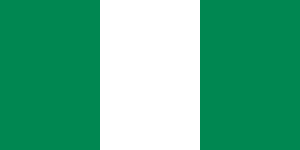Flag of Nigeria facts for kids
The flag of Nigeria is a special symbol for the country. It has three vertical stripes: green, white, and green. This design was chosen and officially adopted on 1 October 1960, the day Nigeria became an independent nation. The flag represents the hopes and dreams of the Nigerian people.
What the Colors Mean
The colors of the Nigerian flag were chosen very carefully. Each color has an important meaning:
- Green: The two green stripes on the outside represent Nigeria's rich natural resources. This includes the country's fertile land, forests, and abundant agriculture. It shows how important farming and nature are to Nigeria.
- White: The white stripe in the middle stands for peace and unity. It reminds everyone that Nigerians want to live together peacefully and work as one nation.
These colors together tell a story of a country that values its land and strives for harmony among its people.
How the Flag Was Chosen
The design for Nigeria's national flag was picked through a special competition. This competition was held in 1959, just before Nigeria gained its independence. Many people submitted their ideas for the flag.
Out of all the entries, a design by a student named Michael Taiwo Akinkunmi was chosen. He was studying at Norwich Technical College in London at the time. His original design had a red sun badge in the middle of the white stripe, but this was later removed by the judges. The simple green, white, and green design was considered perfect to represent the new nation.
Celebrating the Flag
The Nigerian flag is a proud symbol for all Nigerians. You can see it flying high on government buildings, schools, and during national celebrations. It reminds people of Nigeria's independence and its journey as a nation. The flag is a way to show national pride and unity.
Images for kids
-
Flag at the Nigerian embassy, Washington, DC
See also
 In Spanish: Bandera de Nigeria para niños
In Spanish: Bandera de Nigeria para niños





















